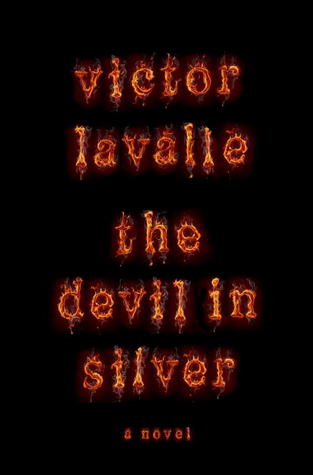Victor LaValle is no stranger to the supernatural, disturbed minds, or the borough of Queens! His first two novels, Big Machine and The Ecstatic, are set in Queens and include cult-survivors, paranormal investigations, and schizophrenia. But it would be a mistake to think that his new novel The Devil in Silver and companion novella Lucretia and the Kroons are covering the same ground. With these, LaValle leaves the plausible dark comedy behind and dives deep into the modern gothic novel.
Pepper, the protagonist of The Devil in Silver, has accidentally roughed up a couple of undercover cops. Well, he meant to rough them up, he just didn’t mean for them to be cops, and in retribution they’ve stuck him in the New Hyde mental hospital in Queens for 72 hours of observation. Pepper’s not crazy, he’s just pissed off. Or at least, that’s what he goes in believing. But three days becomes three weeks, the end is nowhere in sight, and Pepper’s sanity is starting to fray at the edges.
The longer that Pepper stays, the better he gets to know the other inhabitants. Dorry, an elderly woman and the friendliest of the lot, seems harmless enough. Loochie, a punky and bitter teenager, becomes an unlikely ally over time. And Coffee, Pepper’s roommate, seems alright aside from his unhealthy obsession with calling up government officials. Not a bad bunch for a nuthouse. Aside from fighting off boredom, frustration, and his meds, there’s not a lot for Pepper to do besides plot his escape (complicated by the doses of Haldol and lithium he’s forced to take) or bide his time and wait to be released. And if it weren’t for the New Hyde Devil, he’d probably just have done the latter.
There’s a reason that no one will go down the fourth hallway. The smell, the strange noises, the very atmosphere reeks of fear. As if one creepy, off-limits hallway wasn’t enough, there are the suddenly-missing patients that the staff won’t talk about; frightening visitations in the night; strange noises coming from overhead. Is it a delusion, a man, or a monster? I don’t think I spoil anything when I tell you, the answer is: Yes.

The Devil in Silver manages to be a modern horror story, a takedown of the mental health system, and an homage to the psychological thriller all at once. Half the fun of reading it is sorting out the references; just a quick glance through yields The Monkeywrench Gang, Poltergeist, and Fight Club tucked between the lines, and more upfront shout-outs to Ken Kesey, Jaws, Van Gogh, and the unfortunate always-dead-first black guy in sci-fi movies. Much like Joss Whedon’s Cabin in the Woods (which if you haven’t seen yet, I cannot recommend it enough) it manages to pull the pigtails of a genre while using some of its most effective tropes to create a story both familiar and new.
For the most part, LaValle keeps us close to Pepper in a third-person-close perspective, complete with parenthetical asides. He’s an Everyman hero, entertaining, likeable, and a total dunce. There are occasional forays off with other characters, adding a few more layers to the story, but fortunately not too many—Pepper is the undisputed star. His journey from “angry white schmoe” to “potentially mentally unhinged” to “slightly less angry and slightly more contemplative schmoe” is gripping and well-paced.
But the novel isn’t all growth and self-development; it’s also morbid, creepifying, and occasionally gory. (Gory, as in, probably don’t be eating when reading the final third of this book.) The inmates’ terror, the staff’s unthinking incompetence, and the state’s malign neglect combine to create an environment of chilling unpredictability and unaccountability, allowing a demon to roam the halls at will. There are moments of brightness in the dark, and levity to balance out the horror, but the shadows are always right there waiting.
 The digital-only companion novella Lucretia and the Kroons sheds more light on Lucretia, aka Loochie, one of the best secondary characters in The Devil in Silver (I won’t pick one, you can’t make me!), and more doubt on the true mental state of New Hyde’s patients. Instead of spending her twelfth birthday enjoying cake and laughs, she is forced to enter a boarded-up apartment to save her best friend. The apartment turns out to be a gateway to a bizarro Queens, inhabited by meth-addicts-turned-monsters, flying rats, and other horrors. 6D is the darkest twist on Narnia since Lev Grossman introduced us to Fillory, and utterly worth the $0.99 price of admission.
The digital-only companion novella Lucretia and the Kroons sheds more light on Lucretia, aka Loochie, one of the best secondary characters in The Devil in Silver (I won’t pick one, you can’t make me!), and more doubt on the true mental state of New Hyde’s patients. Instead of spending her twelfth birthday enjoying cake and laughs, she is forced to enter a boarded-up apartment to save her best friend. The apartment turns out to be a gateway to a bizarro Queens, inhabited by meth-addicts-turned-monsters, flying rats, and other horrors. 6D is the darkest twist on Narnia since Lev Grossman introduced us to Fillory, and utterly worth the $0.99 price of admission.
Together, The Devil in Silver and Lucretia and the Kroons probe the boundaries of sanity and insanity, reality and the supernatural, and ask us to reconsider our society’s mechanisms for patrolling those boundaries. Anyone with a fondness for things that go bump in the night should pick these up—albeit maybe with flashlight in hand.
Jenn Northington has been a bookseller since 2005, and is currently the events manager at WORD in Brooklyn. She also writes for Book Riot, is a founding member of the Bookrageous podcast, and aspires to be a big damn hero when she grows up.










